Abstract
The study addresses sustainable development in the forest and recreational park of Germia in the Capital City of Kosovo. The park serves the residents and other visitors’ socioeconomic and environmental needs, such as leisure, sports, meditation, and biodiversity and ecological roles. Sustainable management and the development of natural resources are a development that meets the needs of the present without compromising future generations’ ability to meet their own needs. The study used the contingent valuation method to assess willingness to pay for the sustainable management and development of Germia forest and recreational park, given the values it serves the people. The study surveyed 208 respondents about their opinions on the willingness to pay for the sustainable management and development of the forest and recreational park. The results showed that 56% were willing to pay for recreational services, while 44% were against it because they were not satisfied with the park’s services. The majority (62%) were also willing to pay for this service in tax from their salaries. This showed that an average percentage of people were willing to pay for the sustainable management and development of the forest and recreational park. Therefore, this study serves as a basis for future similar studies and policy decisions for park development.
1. Introduction
It is strongly thought that developing more sustainable municipalities is not only a question of improving the abiotic and biotic characteristics of urban life, but also a query of the social features of city life, such as an individual’s experiences, gratification, and perceptions of the quality of their environments [1,2,3]. Sustainable development cannot be undervalued as far as sustainable resources management is concerned. Sustainable development is a development that meets the needs of the present without compromising the ability of future generations to meet their own needs. The management of municipality and urban forests ought to serve the current needs of the people without threatening future uses and benefits associated with the forest park [1,2,3,4,5].
Currently, globally, forest management comprises many activities, these being ecological, economic, and social. The most common and essential business activity is the production and trade of wood. At the same time, in the social domain, forest management is geared towards the quality and quantity of goods and services and several functions that influence people’s quality of life in urban areas. The most valuable social function of forests executed by the State Forests is accessibility for the recreation of the population. This aspect is distinctive, compared to other public services [2].
Public and private city parks are among the most described appropriate places for better physical and mental well-being, particularly if such places are well-kept, protected, and accessible. Regarding the public health viewpoint, parks offer low-cost and high-yield wellness prospects [3,4,5,6].
Germia regional forest Park is among the 173 protected areas (PA) in Kosovo. It gained PA status in 1987 (GZK number 43/87) from the Pristina municipality. The forest park covers an area of approximately 1064 hectares. Kosovo has been doing well in its management of forest and recreational parks, irrespective of its instability. Pristina is vital for the neighboring population, citizens, and tourists from the neighboring countries because of the Germia regional forest Park and its associated ecosystems services [7,8,9]. Moreover, the forest park ecosystem’s natural values have been increasing over time in terms of biodiversity, that is, the park’s major biodiversity species, both flora and fauna [7,8,9]. There are suggestions to further increase the size of the park, given the human demands that are threatening the values of the forest ecosystem and biodiversity, hence minimizing dangers on the PA status of the park [7,8,9].
Forest and recreational parks provide services close to homes that are low-cost and free, readily available areas that provide pleasurable physical socioeconomic and psychological benefits (Figure 1). These services are used by most people and would be used to a greater extent if large investments were made in them without compromising forest biodiversity [7,8,9].

Figure 1.
Picture of Germia forest and recreational park.
Ecosystem functions and benefits are characterized as the capability and potential to provide ecosystem services. The forest ecosystems offer many goods and services to anthropological societies such as wild fruits, herbal medicines, mushrooms and other food stuffs, good air, leisure activities, and scenery views [4,5,6]. The recognition of forest goods and services offered by ecosystems and their valuation measurement of these values attached remains a matter of debate amongst scholars [3,4,5,6,7,8,9,10,11,12]. Scholars describe the benefits of forest ecosystems as ecosystem services in terms of provision, production, and support services [3,4,5,6,7,8,9,10,11,12].
Under the Common International Classification of Ecosystem Goods and Services (CICES), the recreational functions and services can be categorized as a social type, which entirely includes the non-physical and generally non-consumptive nature of an ecosystem service that affects the physical and mental wellbeing of people visiting such a facility [10]. A system of assessing the status/values of socio-economic forest functions and services, criteria, and indicators of multifunctional forest management. Consequently, the construction of forest functions and services, and their estimation have been deliberated [11,13].
Therefore, park visitors’ perceptions and Contingent Valuation Method (CVM) such as willingness to pay (WTP) for such protected park values, and urban forest ecosystems is of vital significance to identify existing and prospective “needs” of the local communities and to appreciate the sustainable development of given areas and cities [14,15]. Besides, realizing visitors’ WTP is crucial as stated preferences (SP) helps managers set appropriate values for protected area non-market environmental services [16,17]. The situation is intended to define the market circumstances and qualities which need to be assessed; therefore, the WTP signifies the individual non-market values of the goods and services in question. WTP for natural resource attractions is the most frequently used valuation method [11,12,13,14,15,16,17,18,19,20,21,22,23,24,25].
The contingent valuation method (CVM) is one of the most used procedures for environmental evaluation. The technique asks individuals directly what value they would pay for a given resource and its associated services [11,12,13,14,15,16,17,18,19,20,21,22,23,24,25]. The WTP estimate is a hypothetical non-market value depending on a scenario described to the study participants before asking about the amount of money they are willing to pay. The situation describes the conditions and characteristics of the resource being evaluated; therefore, the WTP reflects an individual’s economic evaluation of the goods in question [5,15,16,17,18,19,20,25,26,27,28,29,30,31,32,33,34,35,36,37,38,39,40,41,42,43,44].
The forest recreation benefits comprise a significant part of the total economic value (TEV) of forest, a progressively significant determinant in multifunctional forest management in protected areas. The recreational function and services are part and parcel of forest functions [15,22,23]. Mainly urban and suburban forest ecosystems are utilized for recreational functions [21].
The significance of forests in recreation and leisure events is generally accepted across the globe. The methodical evaluation of recreational facilities and more non-market benefits is important to integrate forest utilization’s positive externalities into policy and planning decisions. A recognized technique to evaluate the values of non-market goods is the CVM [5,15,25].
Despite the provision of good services and benefits by the forest park ecosystem, its sustainable management has become an issue. The sustainability of forest parks and recreational management has become an issue in the past decade. This concerns both overexploiting the resource and climate change effects by mankind’s resource use behaviors [45]. Forests contribute to the economy and provide multiple products and services that support livelihoods and protect the environment. However, the challenge is to manage the forest’s regenerative capacity in a way that produces benefits now without conceding future benefits and alternatives. This notion is at the core of most views of sustainable forest management (SFM). Recognition that the production and protection functions of forests must be sustained by sound management practice is essential [46]. Several investigations have been conducted on the services and benefits of forests and forest parks and water resources among other natural resources, and their contribution to the national economy in the light of non-market value [7,9,34,35,36,37,38,39,40,41,42,43,44,45,46,47,48,49,50]. However, the sustainable development of the recreation park at Germia has received less attention. Therefore, this study attempted to better understand the perceptions of the forest visitors, especially the people of Pristina municipality, Kosovo, and the value they attach to it. Moreover, this study at the forest and recreation park Germia attempted to obtain the WTP to support sustainability and management efforts as well as future research.
Furthermore, the study aimed to assess the park visitors and their willingness to pay for sustainable management of the Germia forest and recreational park. Contingent valuation (CVM) survey questionnaires were used to achieve this goal. The study hypothesized that:
Hypothesis 1 (H1):
Visitors are satisfied with the services offered at the Germia forest and recreational park.
Hypothesis 2 (H2):
Visitors are willing to pay for recreational services for sustainable management and development of the recreation and forest park in Germia.
2. Materials and Methods
Germia park was acknowledged as a protected area (PA) in the late 1980s (Figure 2). Currently, the park is under the management of a public company “Hortikultura”, which is accountable for preserving the flora and fauna, phytosanitary cleaning, waste management, and regulatory entry into the PAs. Nevertheless, the management team of the Germia forest park still have a lot to do, as the biodiversity of Germia PA continues to degrade despite human and nature relationships and needs to increase again over the next few years [7,9,26,27]. Most of the species are threatened, and some are getting extinct. The protection position of Germia needs to be re-recognized and managed sustainably to improve the protection status of the scenery and species therein.
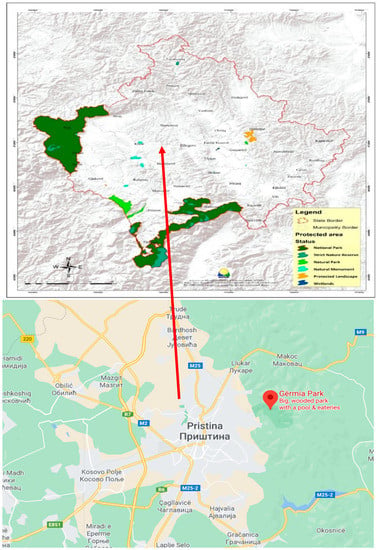
Figure 2.
Map of protected areas in Kosovo, where the orange color represents Germia recreation park located in the capital of Kosovo Pristina.
To attain that, the position of a protected area that doubles as a Regional Park is essential to be transformed into a Protected Landscape. This fits in group V of PAs conferring to the International Union for Conservation of Nature (IUCN). Protected sceneries in “Group V” of the IUCN are demarcated as zones of land with coast or sea as suitable for forests, where the interface of people and nature over time produces an area of distinct character with significant ecological, aesthetic, and cultural values. Such areas often double with high biological diversity, which is entirely in agreement with the Laws for Nature Protection in Kosovo [7,9,26,27].
Based on the Law on Nature Protection, article 19, point 3, and the natural values of this area, the Kosovo Institute for Nature Protection proposes to the Municipal Assembly of Pristina to review this professional proposal and to make a decision, as in point II for the re-categorization of the regional natural park “Germia” in the category Protected Landscape, and expand the area of the protected area that will be included in the new borders of the Protected Landscape. The number of citizens visiting the Park of Germia reaches 1 million within a year [7,9,26,27]. Some of the activities and scenery from the Germia forest and recreational park are presented herein, and they show both leisure and forested ecosystem (Figure 3, see Appendix A). Inside the park, there is also a camp and a swimming pool, including a children’s pool, as well as the offices of the Directorate for Park Management.
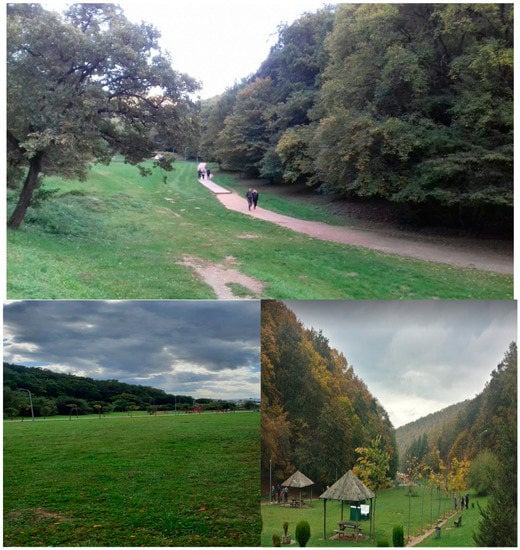
Figure 3.
Some of the Photos of Germia forest and recreation park.
The study based on the contingent valuation method (CVM) used a survey questionnaire to obtain visitors’ opinions on the willingness to pay from the people of Pristina as well as the situation. The study was taken on considering that, currently, the only entrance fees on cars are charged in the park by the horticulture project dealing with park maintenance. The entrance for people is free and hence it is worth knowing the visitors’ opinions regarding the WTP for the park’s sustainable management and development.
The contingent valuation method (CVM) is a significant technique of the non-market valuation of environmental goods and services and assets based on hypothetical choice. Its method is based on survey questionnaire interviews. A population sample referred to as respondents give their opinion in the survey to elicit participants’ preferences and WTP for the resource or willingness to accept (WTA) financial payment to conserve the environmental asset [5,15,16,17,18,19,20,25,26,27,28,29,30,31,32,33,34,35,36,37,38,39,40,41,42,43].
CVM has been mostly used to examine individuals’ WTP for resources while examining several independent variables such as households’ incomes [19,20]. CVM is a technique primarily used to estimate ecosystems’ international monetary values and primarily for the value of the habitats and cultural services [21]. Lastly, CVM is a useful tool to steer policy decision-makers to administer the natural resources of protected areas [17]. This is because WTP estimation is a hypothetical scenario where individuals state their preferences. Their choice can be based on the conditions and characteristics of the resource in question; therefore, the WTP reflects an individual’s economic valuation of the goods under investigation [5,12,13,14,15,16,17,22,23,24,25,26,27,28,29,30,31,32,33,34,35,36,37,38,39,40].
The methodology is based on the compilation of questionnaires, which were completed in the territory of the Germia park. Structured questionnaire questions were used following the work in [25] which equally assessed the WTP for recreational use in a managed forest area. The questions were intended to gather data on the park’s sustainable management and the willingness to pay. The survey took place from November 2018 to December 2018 within the Germia Park territory in Pristina.
The study used a simple random technique to ask respondents for their opinion. This means that all society members had equal chances of being interviewed with a face-to-face approach. All park visitors above the age of 18 years had equal chances of being selected for the interview. The average time for the interview was about 20 min and the lengthy ones were about 30 min. This is because some respondents also asked numerous questions before or even during the interview itself.
To mitigate the WTP bias, the study used cheap talk and follow-up questions [41,42,43]. We talked to the respondents about the park and why it is important for the sustainable development of the park. Mostly, the respondents could express their view on its importance and concerns about the park. The researcher then informed the respondents how important theirs views were for the study as well as improving management and sustainability of the park.
We asked a WTP question, where the respondent answers were “yes” or “no”
After the WTP question, follow-up questions referring to payment vehicles were asked which help to reduce the bias.
Major Questions included.
Are you satisfied with services at the Germia Park?
◯ Yes ◯ No
Are you willing to pay for recreational services for sustainable management and development in Recreation Park Germia?
◯ Yes ◯ No
If you were to be taxed for recreational services, what percentage from your salary would you be willing to contribute to recreational services?
◯ 0% ◯ 1–2% ◯ 3–4% ◯ >4%
The study interviewed 208 people for their opinions on the willingness to pay for the sustainable management and development of the forest and recreational Park of Germia. Many of the respondents were between 18 and 25 years of age (36%), and the gender distribution was 57% males and 43% females. The study used descriptive statistics to analyze the data and this is reflected in the graphic charts. Data were processed with the program sigma plot and graphs. Descriptive statistics provide an overview of the results of the study, hence they are easy to interpret. Statistical differences between groups were analyzed by means of ANOVA.
3. Results
From the survey questionnaire results, it was observed that most of the interviewed people were males at 57% and 43% were females, and 39% had a high school education, while 61% had a university education. The largest percentage of respondents, 39%, were 18–25 years old and 27% of respondents were aged 26–39 years. From 55 to age 65, there is a slight interest in responding to recreational activities in the park of Germia. Compared to the age 18–25, those over the age of 65 were not interested in responding.
The graph (Figure 4) showed the breakdown by age categories, where 18–25 represented the highest number of respondents of other ages.
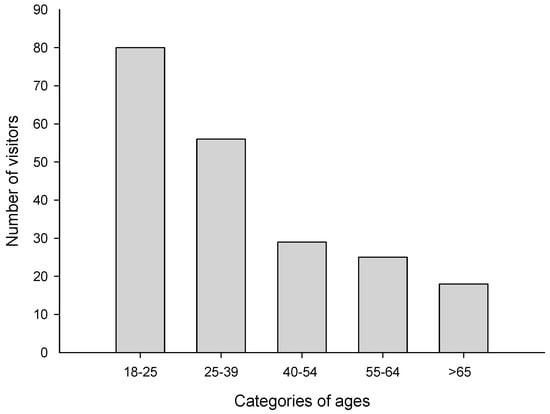
Figure 4.
Categorization of respondents by age against the number of visitors.
Hypothesis 1 (H1):
Visitors are satisfied with the services offered at the Germia recreational and forest park.
The questions asked were: The first question that the respondents were asked was whether they were satisfied with the recreational services offered at Germia Park (Figure 5). About 51% responded negatively, while 47% responded positively, and 2% did not respond.
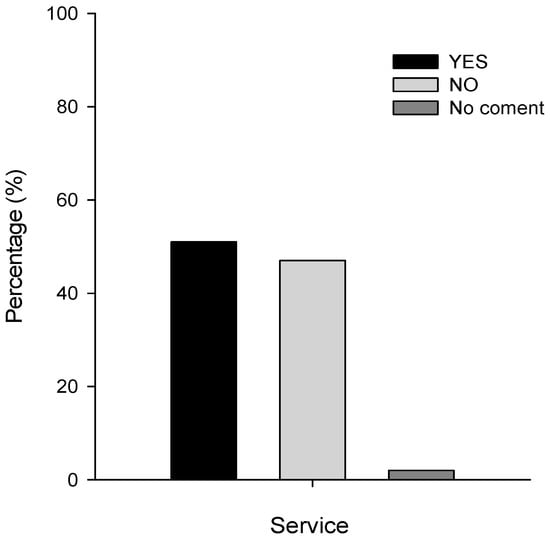
Figure 5.
Respondents’ satisfaction with recreational services.
The second question is divided into four sub-questions about the four services offered at Germia Park (1. Bicycle paths; 2. Pedestrian paths; 3. Landscape regulation; and 4. Signs) with a short response (yes or no).
Regarding pedestrian trails (PL—Pedestrian Lane), 60% of the citizens were satisfied with the pedestrian path while 39% were not satisfied and 1% did not answer this question. Regarding bike paths (BL—Bicycle Lane), 65% of the respondents were not satisfied with the bicycle paths, while 32% were satisfied with the bicycle paths and 3% did not respond to this question. Regarding landscape regulation (LA), 66% of respondents were satisfied with the landscape, while 32% of respondents were not satisfied with the landscape and 2% of respondents did not respond to this question.
Regarding orientation signaling (OL), 32% of respondents were satisfied with the OL, about 66% of respondents were not satisfied, and 2% of respondents did not respond to this question.
In general, 51% were satisfied with the park services, and a specific study of different variables of bicycle paths, pedestrian paths, landscape regulation, and signs stood at about 60% on average. Around 40% were not satisfied with the park services. The respondents gave their views that there were few investments in the forest area by Parks’ Management in Pristina. The respondents argued that all services needed to be improved; for example, “the pedestrian path and bicycle lanes would need to be improved, made bigger and extended to various parts of the forest park than what exists. More signs for directions need to be added across the entire park and stronger legislation is needed which mandates the current investor to keep the sustainability characteristics of the park rather than only maximizing his profits.
Hypothesis 2 (H2):
Visitors are willing to pay for recreational services for sustainable management and development in the recreation park in Germia.
The willingness to pay for the services presented in Germia forest and recreation park results showed that approximately 56% of the respondents were willing to pay while about 44% were not (Figure 6). The study then asked a follow-up question which included WTP and the WTP vehicles as a percentage of income tax.
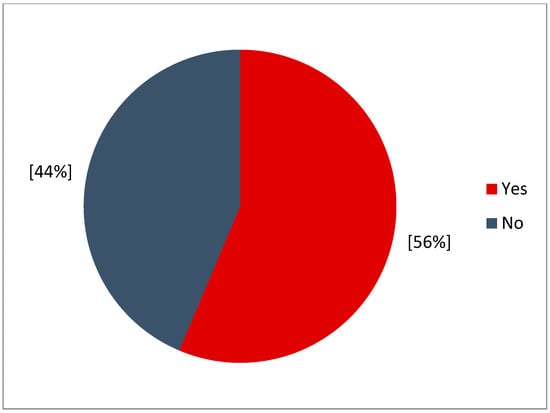
Figure 6.
The willingness to pay for recreational services for sustainable management and development in the recreation park in Germia.
The follow-up survey results illustrated that about 62% of respondents expressed their willingness to pay one of the above percentages (1–2%, 3–4%, >4%). In comparison, 38% of the respondents expressed negativity at the prospect of paying a tax (0%) (Figure 7). The tax value for 1–2% of the income is the most appropriate as it is preferred by 50.5% of the respondents, while the values of 3–4% and 5–7% were less preferred (Figure 7).
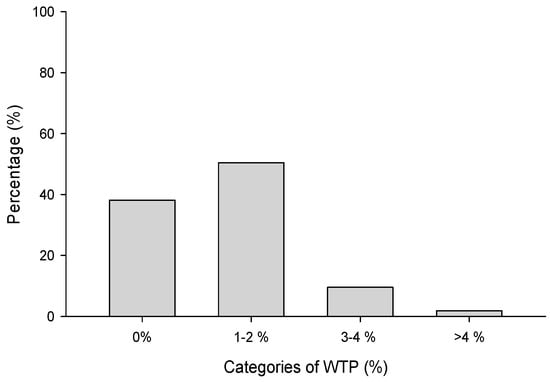
Figure 7.
Visitors’ willingness to pay a tax from their salary for recreational services.
Among the people contacted, the 38% of respondents who were not willing to pay preferred the pre-existing entrance fee for cars worth EUR 1 for each car that enters the Germia Park area and expressed that that money should be enough as a fee for the entrance.
By and large, citizens were willing to pay to help in the forest park’s sustainable management to provide good recreational services, which shows a positive attitude of the citizens to cooperate with the Park Management Department to achieve the strategic objective of the sustainable development of the park.
It should be noted that most participants during the survey expressed that the quality of services should also be improved, which would also increase their readiness and willingness to pay. The WTP with the education levels of respondents showed that 52% had high school education, and 60% had university education. Overall, 48% of the respondents who had high school education were not willing to pay and 42% with a university education were not willing to pay for recreational services for the sustainable management and development of the recreation park in Germia (Figure 8). At both studied levels of education, most were willing to pay for recreational services for sustainable management and development of the recreational park in Germia (Figure 8).
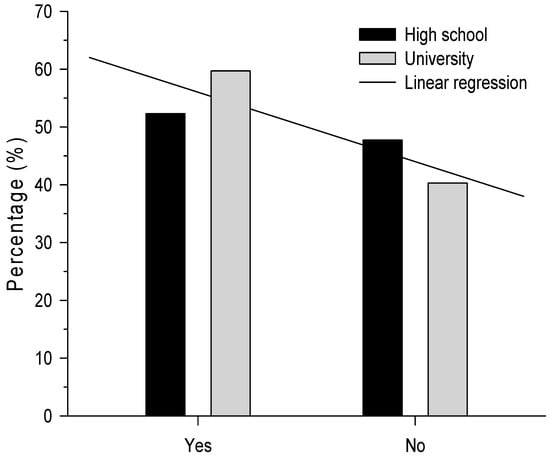
Figure 8.
Visitors’ willingness to pay by education (Series 1 represents high school and Series 2 represents university education).
Figure 9 shows the willingness to pay as percentages (%) of tax of the respondents’ income that were categorized as (0%, 1–2%, 3–4%, >4%) and this was subdivided into the age categories (18–25, 26–39, 40–54, 55–65). Ages 18–25 represented 14% of the total interviewed in this category who were willing to pay tax from their salary. In total, 19% of the total participants in this category were willing to pay 1–2% tax from their salary. In total, 4% of the total respondents in this category were willing to pay 3–4% tax from their salary. In total, 1% of the total participants in this category were willing to pay >4% tax from their salary.
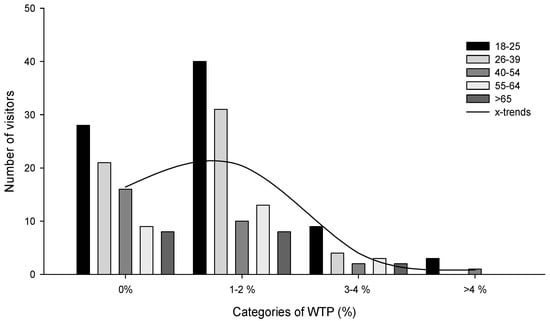
Figure 9.
Willingness to pay (WTP) from their salary on recreational services.
The 26–39 age category represents 10% of the total respondents in this category who were willing to pay 0% tax from their salary. In total, 14.9% of the total respondents in this category were willing to pay 1–2% tax from their salary. In total, 2% of the respondents in this category were willing to pay 3–4% tax from their salary (Figure 9).
Ages 40–54 represent 8% of the total interviewed in this category were not willing to pay tax from their salary. In total, 5% of the total respondents in this category were willing to pay tax from their 1–2% salary. In total, 1% of the total respondents in this category were willing to pay 3–4% tax from their salary. In total, 1% of the total respondents in this category were willing to pay >4% tax from their salary.
Ages 55–64 represent 4% of total respondents in this category who were willing to pay 0% of their tax rate. In total, 6% of total respondents in this category were willing to pay 1–2% tax from their salary. In total, 1.4% of the total respondents in this category were willing to pay 3–4% of their salary.
As shown in Figure 9, the 18–25 and 26–39 age groups represented the highest share of those willing to pay 1–2% tax compared to other age groups. It should also be noted that this age group had the largest number of people interviewed.
The takeaway from Figure 9 is that 62% of respondents expressed their willingness to pay one of the above percentages (1–2%, 3–4%, >4%). In comparison, 38% of the respondents expressed negativity on paying a tax (0%) (Figure 7 and Figure 9).
The ANOVA test, which was used to compare if there exist statistical differences between groups, showed different results between groups. Most of the comparisons were highly significant, except for age groups over 40 years old (Table 1). These results revealed statistically higher male participation as compared to that of females, as well as of people younger than 40 years old as compared to older than 40 years of age and with university as compared to high school studies.

Table 1.
Statistical parameters (F; p, significance level) obtained by ANOVA test between groups. Significant effects are in bold.
According to willingness to pay (WTP) for the sustainable management of the forest park, the satisfaction with the current services saw highly significant differences. For the WTP, pedestrian lane and landscape adjustment presented a great predisposition to pay and satisfaction with those services. Whereas the bicycle lane and orientation signalling revealed poor satisfaction. We see that Germia forest and recreational park is more visited by younger, male visitors and those with university studies than by elderly, female visitors, and those with a high school education, based on highly significant statistical differences between the analysed groups.
4. Discussion
Sustainable resources management is the pillar as far as natural resources management is concerned. The willingness to pay by visitors is a critical factor for the smooth and sustainable utilization of Germia recreational park as an option if a decision is made for sustainable developmental management practices by the management team. Management would decide whether to introduce a payment or not, what amount, and what would be the payment procedure. This WTP study becomes relevant and a baseline for further similar studies to reach much more generalization or more confidence in the decision.
The obtained opinions will be beneficial in the future planning of the Germia forest park and its services. Recreational parks serve several purposes to humans. Access to parks and recreation facilities can lead to healthy lifestyles for humans of all age levels. The games children play in recreational parks, whether sports leagues or summer camps, promote socialization skills and enhance coordination and self-esteem. Through its activities, tourism establishes and offers commercial benefits to the visited areas in the form of transfer of capital and investments from more affluent and more developed zones and regions to the poorer and less developed ones [29,30]. As such, for the recreational park to serve its purposes and be managed sustainably, there should be available funds for smooth operation and a competent team of professionals to manage the park’s administration and ecosystem. Therefore, understanding the value people attach to a forest and recreation park, such as that in Germia, is of paramount importance, given the cost–benefit analysis (CBA) to achieve the best options in the park’s sustainable management. This would involve considering societal needs as well as the environmental needs of the park. The opinions of visitors or citizens of the park are paramount. They help to shape the decision to achieve the optimal and sustainable utilization of the park resources.
This study observed that most people in Pristina were willing to pay taxes for the sustainable management of the Germia recreational park. It was observed that the value of the tax for 1–2% income was the most selected. In general, WTP illustrated that 56% were willing to pay for Germia forest and recreation park’s sustainable management. The follow-up question showed rather promising results, with 62% of the respondents willing to pay a tax towards the same cause. This is a clear and good indication that the people are ready to support the park’s sustainable management and development, and the rest lies in the hands of the management of the park to decide on the best option, given such information. This average score of the WTP could be attributed to the lower satisfaction with the park’s current services. Some others expressed that it is the role of the government to develop and manage the park, even if they do not pay anything.
Herein, the seriousness of the necessity to prompt the values of the non-market functions of forests must be taken critically. This goes beyond the decision to raise funds for the park development and put in practice the systems that do not interfere with the park’s ecosystem and biodiversity. Therefore, services such as pedestrian and bicycle lanes reduce human destructions, and typically people would follow these marked routes. This results in a balance between private and public welfare concerning the optimal utilization of the environmental resources and deciding its importance in line with associated externalities [28].
We used the contingent valuation technique because it is most useful in estimating the monetary values of the non-market environmental resources. These include biodiversity and ecosystems, provisional survives, habitat, and cultural services. Conclusively, the process is an excellent instrument to guide policy decision-makers in environmental management and protected areas. We hope that this study will help in future decisions and in studies about Germia forest and its recreational park. The evaluation process helps to source users to express preferences and have relative values stated. Leisure parks and forests are concurrently a dwelling for nature, gratitude, and relaxation, and a cultural space for many presentations and activities. The parks offer leisure to inhabitants and serve as a traveler’s destination for non-inhabitant visitors. Therefore, recreational parks and forests offer numerous benefits and services: psychological, physical, aesthetic, economic, environmental, social, as well as cultural, recreational, and historical [33,34,35,36,37,38,39,40,41,44,45,46,47,48,49,50,51,52].
Looking at our WTP results compared with some of the previous studies. Some of the respondents insisted that there is no need to pay anything for the use of the forest park services as the government should maintain it; this is line with Březina et al. [28]. Looking at the nature of satisfaction with forest park services and the WTP results, one can argue that even though other factors such as household characteristics affect the WTP, use of the forest services and befits to the society play a vital role. The analysis of aspects of satisfaction with Germia forest and recreational park and the WTP for the park’s sustainable development sets precedence in terms of informativeness of future studies and decision-making processes of the park. Moreover, the study can be replicated elsewhere with some improvements as suggested in this study. Additionally, there are some studies necessary for the methodology support on forest ecosystems services valuation and conservation efforts [28,44,45,46,47,48,49,50,51,52,53,54,55,56,57,58,59,60].
This study suffered a few limitations:
The sample size of 208 was small for the generalization of the finding, although it serves as the basis for future studies, as well as being informative for decision-making policies. A bigger sample with diversity of respondents is necessary in the future to support generalization of findings as well as confident policy decision making.
The study did not assess the visitors’ individual pro-environmental behavior and perceptions of the environment in detail. The follow-up study ought to ask these pertinent behavioral questions to establish what influences peoples’ willingness to pay. Besides, people who do not visit the park could be studied for the future analysis to other ecosystem services in detail to obtain a total economic value (TEV).
Moreover, visitors’ opinions and their WTP help in planning and improving not only the resource ecosystem services utilization but also the sustainable management of the same resources which may suffer damage if not well-managed and protected [18,41,42,43,44,53,54,55,56,57,58,59,60].
5. Conclusions
This investigation was conducted in the Germia recreational and forest park in Kosovo. The study focused on a research survey enquiring about the satisfaction of park services and the WTP of the people of the capital city of Kosovo (Pristina) for the sustainable management and development of recreation areas within the Germia forest park. This is because the sustainable development of Germia park is expressed by the growing needs of Pristina, the capital of Kosovo for large recreational spaces and forest parks [51].
A total of 208 questionnaires were administered to the respondents, who were between the ages 18 and 65 years. Even though the citizens were not satisfied with the Park Management Directorate’s services, the citizens were willing to pay to upgrade these services. About 62% were willing to pay at least 1–2% of their income per year for the sustainable development of the recreational park in Germia. Equally, most of the respondents showed that they would like to pay for these services as tax if the services, such as pedestrian and bicycle lanes, were improved along with other upgrades. Young people were the most willing to pay for the recreational park.
Even though this study presents essential findings that are necessary for policy decisions and further research studies, it is based on a small sample size (208 participants) based in the capital city where the study was conducted. This article contributes to the research base and management option recommendations for the sustainable development of the Germia recreational park. It provides a starting point for the sustainable economic, environmental, and recreational development of the park, and for future studies.
We recommend that the park management team considers the improvement of the pedestrian and cycling paths in the park, as well as the park signs. We recommend that future WTP studies in the same area focus on a larger sample size for more generalization and for better planning of the services and development of the ecosystem and biodiversity at the Germia forest and park.
Author Contributions
Conceptualization, A.D. methodology, A.D.; validation, D.B.; P.K.; P.H.; J.F. and P.K.; investigation, A.D.; resources, P.H.; data curation, J.F.; writing—original draft preparation, A.D.; writing—review and editing, D.B., J.F., O.A. and P.H.; supervision, P.H.; project administration, P.H.; funding acquisition, P.K. All authors have read and agreed to the published version of the manuscript.
Funding
This research was funded by the Ministry of Agriculture of the Czech Republic, Project No. QK1820358.
Institutional Review Board Statement
Not applicable.
Informed Consent Statement
Informed consent was obtained from all subjects involved in the study.
Data Availability Statement
The data presented in this study are available on request from the corresponding author. The data are not publicly available due to nature and sensitivity of the data.
Conflicts of Interest
The authors declare no conflict of interest.
Appendix A
Some of the unique features of the study site (Germia forest and recreational park) [50]. This shows the nature of some of the activities that take place the Germia forest park, which is known as Gërmia park.
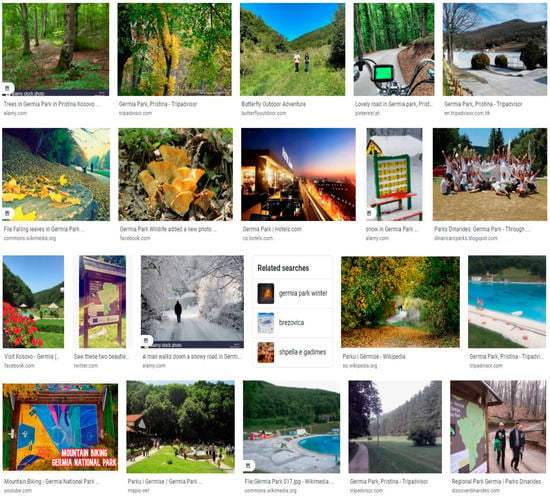
Figure A1.
Some of the unique features of Germia forest and recreational park [52].
References
- Beer, A.R. Urban greenspace and sustainability. In Proceedings of the PRO/ECE-Workshop on Sustainable Urban Development: Research and Experiments, Dordrecht, The Netherlands, November 1993; pp. 1994–1997. Available online: https://scholar.google.com/scholar?cluster=10135726704075397874&hl=en&oi=scholarr (accessed on 3 March 2021).
- Golos, P.; Zając, S. Delimitacja rekreacyjnej funkcji lasów i gospodarki leø enej na terenach zurbanizowanych. Leøene Pr. Badaw. 2011, 72, 83–94. [Google Scholar]
- Sturm, R.; Cohen, D. Proximity to Urban Parks and Mental Health. J. Ment. Health Policy Econ. 2014, 17, 19–24. [Google Scholar] [PubMed]
- Haines-Young, R.; Potschin, M. Proposal for a Common International Classification of Ecosystem Goods and Services (CICES) for Integrated Environmental and Economic Accounting; European Environment Agency: Copenhagen, Denmark, 2010; Volume 30. [Google Scholar]
- Bateman, I.J.; Carson, R.T.; Day, B.; Hanemann, W.M.; Hanley, N.; Hett, T.; Jones-Lee, M.; Loomes, G.; Mourato, S.; Özdemiroglu, E.; et al. Economic Valuation with Stated Preference Techniques: A Manual; Edward Elgar: Northampton, MA, USA, 2002. [Google Scholar]
- Daily GC. Nature’s Services: Societal Dependence on Natural Ecosystems; Island Press: Washington, DC, USA, 1997. [Google Scholar]
- Mustafa, B.; Isufi, F.; Mustafa, N.; Pulaj, B.; Hajdari, A. Gërmia—From a regional park to the protected landscape. Nat. Croat. Period. Musei Hist. Nat. Croat. 2016, 25, 173–184. [Google Scholar] [CrossRef]
- Active Living Research. Parks, Playgrounds, and Active Living. 2010. Available online: www.activelivingresearch.org/files/Synthesis_Mowen_Feb2010.pdf (accessed on 26 September 2020).
- Veselaj, Z.; Mustafa, B. Overview of nature protection progress in Kosovo. Landsc. Online 2015, 45, 1–10. [Google Scholar] [CrossRef]
- Millennium Ecosystem Assessment Board. Ecosystems and Human Well-Being; Island Press: Washington, DC, USA, 2005. [Google Scholar]
- Potschin, M.; Haines-Young, R. Landscapes, sustainability and the place-based analysis of ecosystem services. Landsc. Ecol. 2013, 28, 1053–1065. [Google Scholar] [CrossRef]
- Mavsar, R.; Ramčilović, S.; Palahí, M.; Weiss, G.; Rametsteiner, E.; Tykkä, S.; van Apeldoorn, R.; Vreke, J.; van Wijk, M.; Janse, G. Study on the Development and Marketing of Non-Market Forest Products and Services; European Commission: Brussels, Belgium, 2008. [Google Scholar]
- Merlo, M.; Croitoru, L. Valuing Mediterranean Forests: Towards Total Economic Value; Cabi Publishing: Wallingford, UK, 2005. [Google Scholar]
- Muriuki, G.; Dowd, A.-M.; Ashworth, P. Urban sustainability—A segmentation study of Greater Brisbane, Australia. J. Environ. Plan. Manag. 2016, 59, 414–435. [Google Scholar] [CrossRef]
- Myung, E. An exploratory study of attendee willingness to pay for environmentally friendly meetings. Int. J. Hosp. Tour. Adm. 2017, 18, 272–287. [Google Scholar] [CrossRef]
- Nielsen-Pincus, M.; Sussman, P.; Bennett, D.E.; Gosnell, H.; Parker, R. The influence of place on the willingness to pay for ecosystem services. Soc. Nat. Resour. 2017, 30, 1423–1441. [Google Scholar] [CrossRef]
- Platania, M.; Rizzo, M. Willingness to pay for protected areas: A case of Etna Park. Ecol. Indic. 2018, 93, 201–206. [Google Scholar] [CrossRef]
- Tisdell, C. Valuation of tourism’s natural resources. In International Handbook on the Economics of Tourism; Edward Elgar: Cheltenham, UK, 2006; p. 359. [Google Scholar]
- Bateman, I.J.; Mace, G.M.; Fezzi, C.; Atkinson, G.; Turner, K. Economic analysis for ecosystem service assessments. Environ. Resour. Econ. 2011, 48, 177–218. [Google Scholar] [CrossRef]
- Carson, R. Contingent Valuation: A Comprehensive Bibliography and History; Edward Elgar Publishing: Cheltenham, UK, 2012. [Google Scholar]
- De Groot, R.; Brander, L.; Van Der Ploeg, S.; Costanza, R.; Bernard, F.; Braat, L.; Christie, M.; Crossman, N.; Ghermandi, A.; Hein, L. Global estimates of the value of ecosystems and their services in monetary units. Ecosyst. Serv. 2012, 1, 50–61. [Google Scholar] [CrossRef]
- Rolfe, J.; Windle, J. Multifunctional recreation and nouveau heritage values in plantation forests. J. Econ. 2015, 21, 131–151. [Google Scholar] [CrossRef]
- Hasel, K. Waldwirtschaft und Umwelt: Eine Einführung in die Forstwirtschaftspolitischen Probleme der Industriegesellschaft; P. Parey: Singhofen, Germany, 1971. [Google Scholar]
- Bolund, P.; Hunhammar, S. Ecosystem services in urban areas. Ecol. Econ. 1999, 29, 293–301. [Google Scholar] [CrossRef]
- Carson, R.T.; Flores, N.E.; Martin, K.M.; Wright, J.L. Contingent valuation and revealed preference methodologies: Comparing the estimates for quasi-public goods. Land Econ. 1996, 72, 80–99. [Google Scholar] [CrossRef]
- Ministria e Mjedisit dhe Planifikimit Hapësinor. Report on the State of Nature 2008–2009. Available online: http://www.ammk-rks.net/repository/docs/Raporti_Natyra_Eng.pdf (accessed on 24 July 2019).
- Instituti i Kosovës për Mbrojtjen e Natyrës, Agjencia e Kosovës për Mbrojtjen e Mjedisit, Ministria e Mjedisit dhe Planifikimit Hapësinor. Propozim Profesional për Rikategorizimin e Parkut Regjional Natyror “Gërmia” në Kategorinë Peizazh i Mbrojtur. Available online: http://prishtinaonline.com/uploads/arsyeshmeria-e-germise-drafti-i-fundit-25_01_2015.pdf (accessed on 24 July 2019).
- Březina, D.; Hlaváčková, P.; Fialová, J. Economic evaluation of recreational use of forests roads on the example of Pisek City Forests Ltd. Folia For. Pol. 2017, 59, 312–320. [Google Scholar] [CrossRef]
- Southgate, C.; Sharpley, R. Tourism, development and the environment. In Tourism and Development: Concepts and Issues; Channel View Publications: Bristol, UK, 2002; pp. 231–264. [Google Scholar]
- Walpole, M.J.; Leader-Williams, N. Tourism and flagship species in conservation. Biodivers. Conserv. 2002, 11, 543–547. [Google Scholar] [CrossRef]
- Hlaváčková, P.; Šafařík, D. Metodická Vỳchodiska Kvantifikace Vỳznamu Rekreační Funkce Lesa v Lokální Ekonomice–Představení Projektu; Financovanie: Brno, Czech Republic, 2013. [Google Scholar]
- De Silva, D.G.; Pownall, R.A. Going green: Does it depend on education, gender or income? Appl. Econ. 2014, 46, 573–586. [Google Scholar] [CrossRef]
- Meyer, A. Does education increase pro-environmental behavior? Evidence from Europe. Ecol. Econ. 2015, 116, 108–121. [Google Scholar] [CrossRef]
- Marre, J.-B.; Brander, L.; Thebaud, O.; Boncoeur, J.; Pascoe, S.; Coglan, L.; Pascal, N. Non-market use and non-use values for preserving ecosystem services over time: A choice experiment application to coral reef ecosystems in New Caledonia. Ocean Coast. Manag. 2015, 105, 1–14. [Google Scholar] [CrossRef]
- Han, F.; Yang, Z.; Wang, H.; Xu, X. Estimating willingness to pay for environment conservation: A contingent valuation study of Kanas Nature Reserve, Xinjiang, China. Environ. Monit. Assess. 2011, 180, 451–459. [Google Scholar] [CrossRef] [PubMed]
- Andrews, B.; Ferrini, S.; Bateman, I. Good parks–bad parks: The influence of perceptions of location on WTP and preference motives for urban parks. J. Environ. Econ. Policy 2017, 6, 204–224. [Google Scholar] [CrossRef]
- Matějíček, L.; Benešová, L.; Tonika, J. Ecological modelling of nitrate pollution in small river basins by spreadsheets and GIS. Ecol. Model. 2003, 170, 245–263. [Google Scholar] [CrossRef]
- Mitchell, R.C.; Carson, R.T.; Carson, R.T. Using Surveys to Value Public Goods: The Contingent Valuation Method; Resources for the Future: Washington, DC, USA, 1989; ISBN 9780915707324. [Google Scholar]
- The International Union for Conservation of Nature. IUCN Red List Categories and Criteria, Version 3.1, 2nd ed.; IUCN: Gland, Switzerland, 2012; ISBN 9782831714356. [Google Scholar]
- Hanley, N.; Shogren, J.F.; White, B. Environmental Economics: In Theory and Practice; Macmillan International Higher Education: London, UK, 2016; ISBN 9781349248513. [Google Scholar]
- Bamwesigye, D.; Hlavackova, P.; Sujova, A.; Fialova, J.; Kupec, P. Willingness to Pay for Forest Existence Value and Sustainability. Sustainability 2020, 12, 891. [Google Scholar] [CrossRef]
- Penn, J.; Hu, W.; Cox, L.; Kozloff, L. Resident and tourist preferences for stormwater management strategies in Oahu, Hawaii. Ocean Coast. Manag. 2014, 98, 79–85. [Google Scholar] [CrossRef]
- Penn, J.; Hu, W.; Cox, L.; Kozloff, L. Values for recreational beach quality in Oahu, Hawaii. Mar. Resour. Econ. 2016, 31, 47–62. [Google Scholar] [CrossRef]
- Fialová, J.; Březina, D.; Žižlavská, N.; Michal, J.; Machar, I. Assessment of Visitor Preferences and Attendance to Singletrails in the Moravian Karst for the Sustainable Development Proposals. Sustainability 2019, 11, 3560. [Google Scholar] [CrossRef]
- Fialová, J.; Kupec, P.; Hlaváčková, P.; Šafařík, D.; Mikat, T.; Kala, L. Visitor monitoring of selected trails in ŠLP Křtiny. In Public Recreation and Landscape Protection—With Man Hand in Hand? Fialová, J., Pernicová, D., Eds.; Mendel University in Brno: Brno, Czech Republic, 2014; pp. 340–343. ISBN 978807375952. [Google Scholar]
- Halkos, G.; Leonti, A.; Sardianou, E. Assessing the Preservation of Parks and Natural Protected Areas: A Review of Contingent Valuation Studies. Sustainability 2020, 12, 4784. [Google Scholar] [CrossRef]
- Kim, J.H.; Choi, K.R.; Yoo, S.H. Public Perspective on Increasing the Numbers of an Endangered Species, Loggerhead Turtles in South Korea: A Contingent Valuation. Sustainability 2020, 12, 3835. [Google Scholar] [CrossRef]
- Monserud, R.A. Evaluating forest models in a sustainable forest management context. Biom. Model. Inf. Sci. 2003, 1, 35–47. [Google Scholar]
- MacDicken, K.G.; Sola, P.; Hall, J.E.; Sabogal, C.; Tadoum, M.; de Wasseige, C. Global progress toward sustainable forest management. Ecol. Manag. 2015, 352, 47–56. [Google Scholar] [CrossRef]
- Šodková, M.; Purwestri, R.C.; Riedl, M.; Jarský, V.; Hájek, M. Drivers and Frequency of Forest Visits: Results of a National Survey in the Czech Republic. Forests 2020, 11, 414. [Google Scholar] [CrossRef]
- Riedl, M.; Jarský, V.; Zahradník, D.; Palátová, P.; Dudík, R.; Meňházová, J.; Šišák, L. Analysis of Significant Factors Influencing the Amount of Collected Forest Berries in the Czech Republic. Forests 2020, 11, 1114. [Google Scholar] [CrossRef]
- Germia Park. Available online: https://www.google.com/search?q=germia+park&sxsrf=ALeKk03FCui0eAJov2UtE81miUDKkfE27w:1607085965257&tbm=isch&source=iu&ictx=1&fir=0dqRqjJpiMD72M%252Cxlqgg91SdffPfM%252C_&vet=1&usg=AI4_-kQ5DSQjymmm-fAMbhPgik_Z3JDrKg&sa=X&ved=2ahUKEwiK4tPgrbTtAhVEqaQKHZ_bBjYQ9QF6BAgPEAE&biw=1366&bih=625 (accessed on 4 December 2020).
- Huang, L.F.; Chiang, C.C.; Chen, H.C. Willingness to pay of visitors for the nature-based public park: An extension of theory of planning behavior (TPB). J. Inf. Optim. Sci. 2014, 35, 405–429. [Google Scholar] [CrossRef]
- Kaffashi, S.; Yacob, M.R.; Clark, M.S.; Radam, A.; Mamat, M.F. Exploring visitors’ willingness to pay to generate revenues for managing the National Elephant Conservation Center in Malaysia. For. Policy Econ. 2015, 56, 9–19. [Google Scholar] [CrossRef]
- Bernath, K.; Roschewitz, A. Recreational benefits of urban forests: Explaining visitors’ willingness to pay in the context of the theory of planned behavior. J. Environ. Manag. 2008, 89, 155–166. [Google Scholar] [CrossRef] [PubMed]
- Cheung, L.T.; Fok, L.; Fang, W. Understanding geopark visitors’ preferences and willingness to pay for global geopark management and conservation. J. Ecotourism 2014, 13, 35–51. [Google Scholar] [CrossRef]
- López-Mosquera, N. Gender differences, theory of planned behavior and willingness to pay. J. Environ. Psychol. 2016, 45, 165–175. [Google Scholar] [CrossRef]
- Cheung, L.T. The effect of geopark visitors’ travel motivations on their willingness to pay for accredited geo-guided tours. Geoheritage 2016, 8, 201–209. [Google Scholar] [CrossRef]
- Lee, W.S.; Graefe, A.R.; Hwang, D. Willingness to pay for an ecological park experience. Asia Pac. J. Tour. Res. 2013, 18, 288–302. [Google Scholar] [CrossRef]
- Cheung, L.T.; Jim, C.Y. Expectations and willingness-to-pay for ecotourism services in Hong Kong’s conservation areas. Int. J. Sustain. Dev. World Ecol. 2014, 21, 149–159. [Google Scholar] [CrossRef]
Publisher’s Note: MDPI stays neutral with regard to jurisdictional claims in published maps and institutional affiliations. |
© 2021 by the authors. Licensee MDPI, Basel, Switzerland. This article is an open access article distributed under the terms and conditions of the Creative Commons Attribution (CC BY) license (http://creativecommons.org/licenses/by/4.0/).